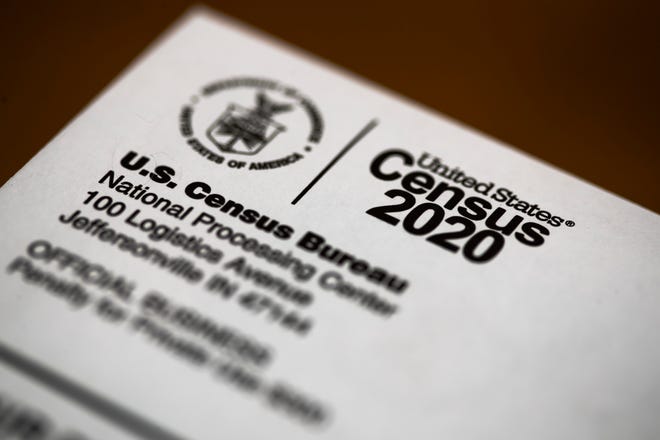Fact check: Census voting data isn’t proof of fraud in 2020 election
The claim: Census data “called into question the official vote tally from the 2020 election”
Six months after America democratically elected President Joe Biden with 81 million votes, unfounded claims of widespread election fraud persist.
Most recently, proponents of the baseless fraud allegation are offering a misleading interpretation of Census data as evidence.
In a May 4 article, The Election Wizard described, “a discrepancy of nearly four million votes” between the number of votes in the 2020 election and data that the U.S. Census Bureau released in April. The Election Wizard cited a pollster that is “convinced the Census data is powerful circumstantial evidence that fraud was afoot in 2020.”
“The results of the 2020 Election are again not supported by evidence,” the Gateway Pundit wrote in a May 9 article trumpeting a “HUGE CONFLICT” in the total number of voters in 2020 Census data.
The claim has also spread through social media posts on Instagram and Twitter.
Fact check:What’s true about the 2020 election, vote counting, Electoral College
This is the most recent is a series of unfounded election fraud claims meant to undermine the certified results. USA TODAY has investigated a wide array of these claims and found no evidence of widespread fraud.
Neither the Election Wizard nor the Gateway Pundit responded to USA TODAY’s request for comment.

Millions are not included in the Census data
It is correct that more than 159 million voters participated in the 2020 election. It is also true that, according to Census Bureau data, 154,628,000 citizens reported they had voted in the 2020 election.
But this number is misleading.
The data comes from the Current Population Survey, which the Census Bureau and U.S. Bureau of Labor Statistics conducted in November. This is a survey, not an exhaustive tally.
Fact check: No evidence election audit in Maricopa County has found widespread election fraud
The number of reported voters is not a definitive number. Rather it describes the individuals that answered they had voted when filling out the 2020 Census.
The Census gave this prompt:
“In any election, some people are not able to vote because they are sick or busy or have some other reason, and others do not want to vote. Did (you/name) vote in the election held on Tuesday, November 3, 2020?”

According to the dataset, 36,404,000 people were not included as answering either yes or no. The Census Bureau said the ‘No response to voting’ category “includes those who were not asked if they voted as well as those who responded ‘Don’t Know,’ and ‘Refused.’”
About 67% of eligible voters cast a ballot in the November election, according to the U.S. Elections Project.
Experts say discrepancy is the result of survey methods
The survey’s technical document specifically explains this data should not be compared to numbers from other sources.
“Data obtained from the CPS and other sources are not entirely comparable. This is due to differences in interviewer training and experience and in differing survey processes,” it reads. “These differences are examples of nonsampling variability not reflected in the standard errors. Therefore, caution should be used when comparing results from different sources.”
Fact check:Biden’s speech had an estimated 26.9 million viewers
According to Michael P. McDonald, the professor of political science at the University of Florida who runs the United States Election Project, the 4 million voters not accounted for in the ‘Reported voted’ category were likely counted among the 36 million in the ‘No response to voting’ category.
McDonald told USA TODAY that the discrepancy likely reflects survey methods. He said questions about voting often appear at the end of the survey and do not require a response.
“The Census Bureau report is from a survey, with sampling and non-sampling errors. They are not the actual election results, and should not be treated as such,” he said.
Barry Burden, professor of American politics and political methodology at University of Wisconsin-Madison, told USA TODAY the discrepancy is “not a sign of fraud” rather a result of sampling error.
“It is backwards and misleading to assume that the Census estimates are the ‘truth’ and that the official data from state election officials are in doubt if they disagree,” he wrote in an email.
Our rating: False
The claim that a discrepancy between the total votes in the 2020 election and Census data proves there was widespread fraud is rated FALSE, because it is not supported by our research. The difference is related to the methods used by the Census, which resulted in 36 million people not answering whether or not they voted. Because of this, the Census specifically warns against comparing the Census tallies to other data sources. Election experts and U.S. courts have repeatedly found allegations of election fraud to be unfounded.
Our fact check sources:
- USA TODAY, Dec. 15, 2020, Fact check: Joe Biden legally won presidential election, despite persistent contrary claims
- USA TODAY, Dec. 30, 2020, Fact check: Over 159 million people voted in the US general election
- United States Census Bureau, April, Voting and Registration in the Election of November 2020, Reporting Voting and Registration, by Sex and Single Years of Age: November 2020
- USA TODAY, Nov. 17, 2020, Fact check: What’s true about the 2020 election, vote counting, Electoral College
- United States Elections Project, Dec. 17, 2020, 2020 November General Election Turnout Rates
- U.S. Census Bureau, accessed April 11, CURRENT POPULATION SURVEY, November 2020 Voting and Registration Supplement TECHNICAL DOCUMENTATION
- Email and phone call with Michael P. McDonald, professor of political science, University of Florida, United States Election Project, April 11
- Email with Barry Burden, professor of American politics and political methodology, University of Wisconsin-Madison, April 11
Thank you for supporting our journalism. You can subscribe to our print edition, ad-free app or electronic newspaper replica here.
Our fact check work is supported in part by a grant from Facebook.


